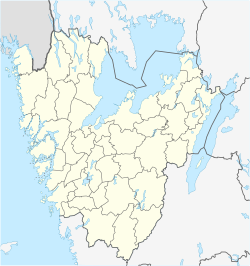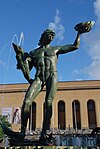art.wikisort.org - Museum
Gothenburg Museum of Art (Swedish: Göteborgs konstmuseum) is located at Götaplatsen in Gothenburg, Sweden. [1] It claims to be the third largest art museum in Sweden by size of its collection.[2]
This article may be expanded with text translated from the corresponding article in Swedish. (March 2022) Click [show] for important translation instructions.
|
 | |
 Location within Västra Götaland | |
| Established | 1925 |
|---|---|
| Location | Gothenburg, Sweden |
| Type | Art museum |
| Website | goteborgskonstmuseum |
Collections


The museum holds the world's finest collection of late 19th century Nordic art. A highlight is the lavishly decorated Fürstenberg Gallery, named after a leading Gothenburg art donor, Pontus Fürstenberg and his wife Göthilda. Among the artists showcased are P.S. Krøyer, Carl Larsson, Bruno Liljefors, Edvard Munch, and Anders Zorn.[3]
The museum also houses older and contemporary art, both Nordic and international. The collection includes, for example, Monet, Picasso and Rembrandt. The Museum has been awarded three stars in the Michelin Green Guide (Green Guide Scandinavia).[4]
Architecture
The museum building was designed for the Gothenburg Exhibition (Jubileumsutställningen i Göteborg) in 1923 by architect Sigfrid Ericson (1879-1958). The eastern extension was added 1966–1968, after drawings by Rune Falk (1926-2007). The museum was originally built in celebration of the city's 300th anniversary, and represents the monumental Neo-Classical style in Nordic architecture. It is built of a yellow brick called ”Gothenburg brick” because of the material's frequent use in the city. The museums forms the imposing end of the main street of the city, Kungsportsavenyn.[5] [6]
History
The museum has its roots in the Museum of Gothenburg, founded in 1861. In 1923, as part of the construction of Götaplatsen as a cultural center, the museum's building was built. In 1925, the museum was inaugurated. It was expanded in 1968 and 1996.[2]
Gallery
- Emigration (1872) Geskel Saloman
- Hip, Hip, Hurrah! Kunstnerfest på Skagen (1886) P.S. Krøyer
 Ute (1888) Anders Zorn
Ute (1888) Anders Zorn Olive Grove, Saint-Rémy (1889) Vincent van Gogh
Olive Grove, Saint-Rémy (1889) Vincent van Gogh- Katt på fågeljakt (1883) Bruno Liljefors
- Näckrosors (1907) Claude Monet
See also
- Hasselblad Foundation
References
- "Göteborgs konstmuseum". Avenyföreningen. Retrieved March 1, 2020.
- "About the Museum". Göteborgs Konstmuseum.
- "Gothenburg Museum of Art | Gothenburg | Sweden | AFAR". www.afar.com. 2017-10-09. Retrieved 2019-11-05.
- Lembke, Judi. "The Top Museums in Gothenburg, Sweden". Culture Trip. Retrieved 2019-11-05.
- "Visit the Museum". Museum of Gothenburg. Retrieved 2019-11-05.
- "Ericson, Sigfrid (1879-1958)". KulturNav. Retrieved March 1, 2020.
External links
На других языках
[de] Göteborgs konstmuseum
Göteborgs konstmuseum ist ein Kunstmuseum in Göteborg in Schweden. Die Sammlungen des Kunstmuseums umfassen ca. 70.000 Werke vom 15. Jahrhundert bis zur zeitgenössischen Kunst. Ihr Schwerpunkt liegt auf nordischer Kunst, sie enthalten aber auch Werke aus dem übrigen Europa sowie aus den USA.[1]- [en] Gothenburg Museum of Art
[fr] Musée des Beaux-Arts de Göteborg
Le musée des Beaux-Arts de Göteborg (en suédois : Göteborgs konstmuseum) est un musée à Göteborg (Suède). Il possède la plus importante collection d'art scandinave des années 1880 et 1890 en Suède.[ru] Гётеборгский художественный музей
Гётеборгский художественный музей (швед. Göteborgs konstmuseum) — музей изобразительных искусств в Гётеборге, является третьим по величине художественным музеем Швеции после Национального музея и Музея современного искусства в Стокгольме.[2]Другой контент может иметь иную лицензию. Перед использованием материалов сайта WikiSort.org внимательно изучите правила лицензирования конкретных элементов наполнения сайта.
WikiSort.org - проект по пересортировке и дополнению контента Википедии






